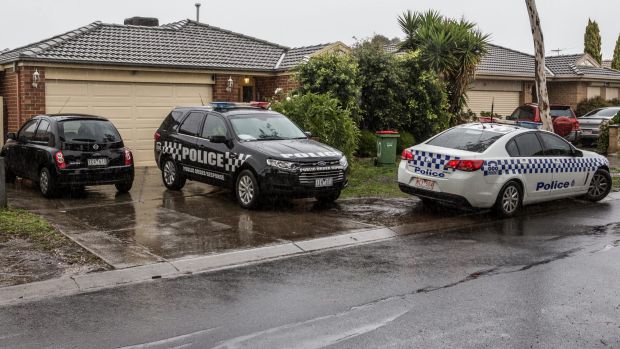- Live: Explosions heard at the scene of the Melbourne terror attack
- Gunman took hostage to lure anti-terror police
The man behind the deadly Brighton terror attack, Yacqub Khayre, had a history of drug abuse and violence, which included repeatedly committing serious offences while on bail.
More National News Videos
Brighton Siege: Who was the gunman?
An IS-motivated gunman who was out on parole has been killed at the scene of the Brighton siege. A woman was taken hostage and an employee of the Brighton serviced apartments has been killed.
Since the age of 16, Khayre spent more time inside prisons or youth justice facilities than outside them, usually lapsing back into methamphetamine use upon release.
Born in Mogadishu in 1987, Khayre was considered a "peripheral player" in the anti-terror investigation code-named Neath, while possible links to terrorist organisations, including Islamic State and Somalian-based al-Shabaab, are now under investigation by state and federal law enforcement agencies.

Khayre arrived in Australia as a child, after he and his grandparents fled Somalia and spent time in a Kenyan refugee camp.
His parents later joined him in Melbourne, but Khayre resisted their attempts to give him a "conservative, traditional, and strict" upbringing. He grew up around Broadmeadows and Roxburgh Park, according to court documents.
Following the death of his grandfather – who was a guiding figure and respected member of Melbourne's Somali community – Khayre's life lurched out of control.
Aged 17, Khayre was charged with more than 40 offences, including burglary, assault, methamphetamine possession, bail breaches and resisting arrest.

A magistrate granted him bail, but within months he was charged with armed robbery, after stabbing a man twice in the leg when he refused to hand over a wallet and mobile phone.
At the time, a judge expressed concerns about Khayre's drug and alcohol abuse and his "failure to take advantage of the assistance that has been granted to you whilst you were on bail", according to court documents.

Khayre was handed a fully suspended sentence, but was charged eight months later with burglary. He again avoided a custodial sentence, and was released on an adjourned undertaking.
Police believe Khayre became radicalised in about 2008, after attending a Preston mosque along with other men charged in relation to a 2009 plot to storm Sydney's Holsworthy Barracks and kill as many soldiers as possible.

A key figure in that planned attack, Somali refugee Saney Aweys, took Khayre under his wing and sent him to Somalia to train with terrorist organisation al-Shabaab.
The then 22-year-old flew to Singapore first, and then on to Doha, and Kenya.
Khayre spoke regularly to Aweys, who was later jailed over his role in the terrorist plot. He spoke of the "culture shock" on arriving back in Somalia, and struggled to operate his mobile phone.
On April 26, 2009, Khayre told Aweys that his new name would be Abu Abdirahman.
But Aweys worried that Khayre posed a threat to their secret plan, telling a Somali contact he was: "a risk to you, us and the whole thing", according to transcripts of telephone intercepts.
On June 28, 2009, Khayre fled from the training camp in Somalia. They heard from him in Nairobi the next day, when he asked for money to come home.
After he arrived back in Australia on July 14, doubts about Khayre grew. Aweys said he thought he was a liar and word spread that Khayre "ran away from the brothers" in Somalia.
Following his acquittal and release from prison in late 2010, Khayre again started using methamphetamine.
A legal source, who met Khayre on several occasions, expressed concern he was never considered for a deradicalisation program.
"It was an opportunity missed. He had plenty of problems, mostly the drugs, but he seemed like a young guy who was easily led. And he could have been led in another direction," the source said.
They also claimed he was also deeply traumatised by his 16-month stint in a maximum security prison.
In 2011, Khayre was sentenced to almost four months in prison over firearms charges, including being a prohibited person found in possession of a gun and bail breaches.
Again under the influence of ice, Khayre was involved in a violent home invasion in Dallas, where he repeatedly bashed a young woman who interrupted him as he ransacked the house. He also head-butted the woman's father, before he was overpowered and arrested.
At the 2012 trial, a judge noted his total estrangement from family and friends.
"There was no family at court to support you. You have had few visits, only from one sibling, but no other contact with family or community members. I am told that they have washed their hands of you," said County Court Judge Felicity Hampel in 2012.
He was sentenced to more than three years prison over the home invasion, and granted parole in December 2016.
The family's Roxburgh Park home, where Khayre lived as a teenager, is owned by Dr Hussein Haraco, the secretary of the Somali Australian Council of Victoria, which has run a program to fight the radicalisation of youths since 2015.
Dr Haraco said Khayre was too old to be involved in the program, and that despite his criminal history, the Brighton attack had come as a shock.
"I know the mother very well, not Khayre actually, but I know the mother very well and she's a very good person. I contacted her before. She's a very strong woman who raised the children without their father," Dr Haraco said.
Dr Haraco said Khayre had little contact with the community but that he was aware of his criminal past..
"We never thought that [Khayre] will do something like this and say that 'I'm doing this with Al-qaeda or ISIS'," he said.
Dr Haraco said he was concerned about the safety of the family and other members of the Somali community in the wake of the attack.














